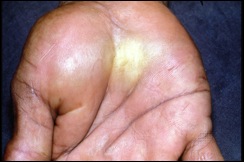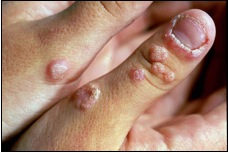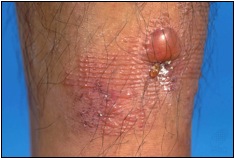Skin growths
Q. What is the difference between a callus, corn, blister and wart?
Callus – A callus (also known as callosity) is a painless area of hard thickened skin that is larger than a corn. Calluses are found at sites of repetitive pressure or friction. They develop as a response to chronic repetitive trauma to a localised skin area, with the upper layers of the skin growing thicker as a form of protection against blistering.
For instance, calluses may develop on the soles of long-distance runners, as well as on the hands and fingers of people exposed to chronic frictional stress, such as violin players, bowlers and carpenters.
Corn –A corn (also known as clavus) is a small rounded area of hard thickened skin that is commonly found at sites of chronic pressure or friction, such as the fingers, top surface of toes and the outside of the little toe. Occasionally, a corn can be soft if it is located in between adjacent toes, due to maceration from sweat. Corns may be inflammed and are often painful.
In terms of treatment for a corn or callus, the most important aspect is to relieve recurrent mechanical stress to the affected area. For instance, it will be helpful to wear comfortable fitting shoes with pressure-relieving insoles if you spend long hours on your feet each day. If appropriate, wear protective gloves to prevent repetitive movements from traumatising the skin of your hands and fingers. Keratolytic agents such as salicylic acid can be used to reduce the thickness of the corn or callus, while regular application of emollients helps to soften the skin. Physical modalities such as regular paring with a pumice stone can also be employed to smoothen the thickened skin.
Wart – A wart is a benign skin growth caused by the human papillomavirus (HPV) infecting the top layers of the skin. It is common in both children and adults, and is infectious. A wart can be transmitted either by direct skin contact, or by auto-inocculation when scratching spreads the virus to another area of the skin. Warts often have a hard ‘cauliflower-like’ uneven surface, and demonstrate black dots (representing clotted blood vessels) or red bleeding spots when the overlying thickened skin is scraped off.
Treatment options can be broadly divided into topical therapy and destructive (ablative) therapy. Topical agents that are used to treat warts include salicylic acid, 5-fluorouracil, podophyllin and imiquimod. Ablative treatments include cryotherapy (freezing with liquid nitrogen), electrosurgery and carbon dioxide laser. Your doctor can formulate an appropriate treatment plan for you based on the size and location of your wart, your treatment history and preferences.
Blister – A blister is a small bubble or pocket of fluid that forms in the skin. Most blisters are filled with clear pale yellowish-coloured serum. Occasionally, blisters may be filled with blood, or pus if they become infected. Blisters can develop anywhere on the face, body and limbs. There is a long list of possible causes for a blister, such as trauma (friction, heat), contact with chemicals, infections (viral, bacterial, fungal), drug allergies, hereditary blistering skin disorders, autoimmune blistering skin disorders such as pemphigus and pemphigoid, as well as inflammatory skin diseases such as eczema – the list is non-exhaustive.
In terms of treatment, a large blister can be pricked with a sterile needle and the fluid expressed to relieve discomfort, without removing the overlying skin which acts as a natural protective layer to aid healing. Infected blisters should be drained and treated with oral and topical antibiotics. If you are unsure of the cause of your blister, or if you find yourself getting recurrent blisters, it is advisable to see your doctor who will ascertain the root cause and provide you with appropriate treatment. – Dr Eugene Tan, associate consultant dermatologist, National Skin Centre
(** PHOTO CREDITS: National Skin Centre)





0 Comments